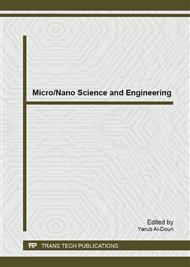[1]
J. L. Vicente, A. Albesa, J. L. Llanos, E. S. Flores, A. E. Fertitta, D. B. Soria, et al., Effect of acid oxidation treatment on adsorption properties of arc-discharge synthesized multiwall carbon nanotubes, The Journal of the Argentine Chemical Society, vol. 98, pp.29-38, (2011).
Google Scholar
[2]
E. Salernitano, L. Giorgi, T. Dikonimos Makris, R. Giorgi, N. Lisi, V. Contini, et al., Purification of MWCNTs grown on a nanosized unsupported Fe-based powder catalyst, Diamond and Related Materials, vol. 16, pp.1565-1570, 8/ (2007).
DOI: 10.1016/j.diamond.2006.12.038
Google Scholar
[3]
J. K. Radhakrishnan, P. S. Pandian, V. C. Padaki, H. Bhusan, K. U. B. Rao, J. Xie, et al., Growth of multiwalled carbon nanotube arrays by chemical vapour deposition over iron catalyst and the effect of growth parameters, Applied Surface Science, vol. 255, pp.6325-6334, 4/1/ (2009).
DOI: 10.1016/j.apsusc.2009.02.010
Google Scholar
[4]
N. A. Buang, F. Fadil, Z. A. Majid, and S. Shahir, Characteristic of mild acid functionalized multiwalled carbon nanotubes towards high dispersion with low structural defects.
Google Scholar
[5]
Z. Wang, M. D. Shirley, S. T. Meikle, R. L. Whitby, and S. V. Mikhalovsky, The surface acidity of acid oxidised multi-walled carbon nanotubes and the influence of in-situ generated fulvic acids on their stability in aqueous dispersions, Carbon, vol. 47, pp.73-79, (2009).
DOI: 10.1016/j.carbon.2008.09.038
Google Scholar
[6]
B. Munkhbayar, M. Bat-Erdene, B. Ochirkhuyag, D. Sarangerel, B. Battsengel, H. Chung, et al., An experimental study of the planetary ball milling effect on dispersibility and thermal conductivity of MWCNTs-based aqueous nanofluids, Materials Research Bulletin, vol. 47, pp.4187-4196, 12/ (2012).
DOI: 10.1016/j.materresbull.2012.08.073
Google Scholar
[7]
J. Ngoy, S. E. Iyuke, W. Neuse, and C. Yah, Covalent Functionalization for Multi-Walled Carbon Nanotube (f-MWCNT)-Folic Acid bound bioconjugate, Journal of Applied Sciences, vol. 11, pp.2700-2711, (2011).
DOI: 10.3923/jas.2011.2700.2711
Google Scholar
[8]
S. Khalili, A. A. Ghoreyshi, and M. Jahanshahi, Carbon dioxide captured by multi-walled carbon nanotube and activated charcoal: A comparative study, Chemical Industry and Chemical Engineering Quarterly, pp.50-50, (2012).
DOI: 10.2298/ciceq120217050k
Google Scholar
[9]
M. M. Gui, Y. X. Yap, S. P. Chai, and A. R. Mohamed, Amine‐functionalization of multi‐walled carbon nanotubes for adsorption of carbon dioxide, Asia‐Pacific Journal of Chemical Engineering, (2012).
DOI: 10.3850/978-981-07-1445-1_404
Google Scholar
[10]
M. Fan, C. P. Huang, A. E. Bland, Z. Wang, R. Slimane, and I. G. Wright, Environanotechnology: Elsevier Science, (2010).
Google Scholar
[11]
M. N. Tchoul, W. T. Ford, G. Lolli, D. E. Resasco, and S. Arepalli, Effect of mild nitric acid oxidation on dispersability, size, and structure of single-walled carbon nanotubes, Chemistry of Materials, vol. 19, pp.5765-5772, (2007).
DOI: 10.1021/cm071758l
Google Scholar


